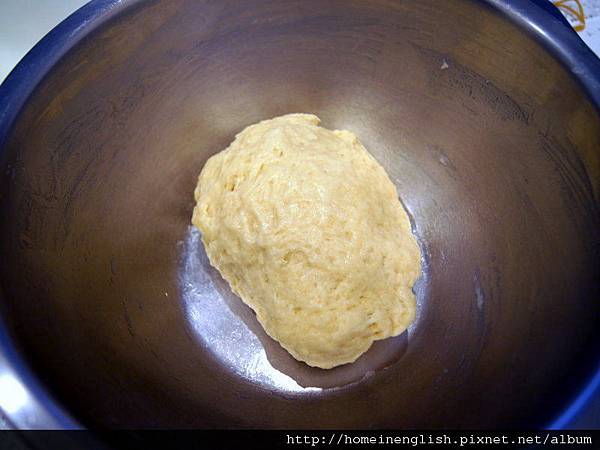In Recipe #294, the steamed rolls are made with the colorful purple Chinese yam and pumpkin. Each with its own distinct, light, and unique flavor.
The purple Chinese yam and pumpkin are used as pastes in the steamed rolls because they have about 82% water content which is much higher than the dough of the steamed rolls. So it is not feasible to use them as sticks or cubes. Once the nicely shaped rolls are steamed, water comes out of the yam and pumpkin pastes, the result is flattened steamed rolls without any of the soft and fluffy texture.
The water content of the taro root and sweet potato is about 69% which is similar to the steamed roll dough. Of course one can choose to use the taro and sweet potato as pastes in this recipe but the unique texture and taste of these vegetables is best represented when they are coarse like the sticks and cubes.
Many of the taro steamed rolls sold in the Asian supermarkets and in some restaurants are purple with taro taste without actual bits of taro at all. These steamed rolls are basically plain dough with purple food coloring and artificial taro flavoring! So why subject ourselves to these chemicals? These homemade rolls are healthy with beneficial nutrients.
Taro steamed rolls with taro bits taste great, 100% natural, and healthy. They have a rustic look because they are homemade!
Taro Steamed Roll
Yield: 14
Ingredients
Dough
Water – 135 g
Rapid rise yeast – ½ tablespoon
All purpose flour – 300 g
Sugar – 60 g
Salt – ⅓ teaspoon
Oil – 40 g
Taro Preparation
Taro peeled – 300 g
Sugar – 20 g (see note 1)
All purpose flour – 100 g
Steps
1) Put dough ingredients (except oil) into a bowl and mix with a pair of chopstick or hands.
2) Once the ingredients start to come together, add the oil and knead the dough until everything is well mixed and come together like a ball.
3) Cover the bowl and let the dough rest and rise for 2 hours in a warm place (28°C or ~80 – 85°F). The dough will double in size.
4) While the dough is resting, peel the taro and cut into medium-sized sticks. Layer the taro sticks on a plate and steam for 5 minutes. About half way through steaming, rearrange the taro stick layers so all sticks are exposed to the steam evenly. The taro sticks will be half way cooked after 5 minutes. See note 2.
5) After steaming, put the taro sticks into a bowl and toss with 20 g of sugar while they are still warm then let them cool down.
6) Once the sugared taro sticks are cooled completely, toss them with 100 g of all purpose flour then add them to the rested dough. Knead the dough and taro sticks until they are incorporated.
7) Cut the dough into 14 equal sized portions. Each portion will weigh around 68 g.
8) Lightly shape each small dough into round rolls. Place the rolls in the steaming baskets lined with steaming lining paper (to prevent the rolls from sticking to the bottom of the steaming basket). Allow adequate room between each roll to prevent the rolls from sticking to each other while steaming.
9) Cover the steaming baskets and let the rolls sit in a warm place (38°C or ~100°F) for 20 – 30 minutes to rise again. The rolls are ready to steam when it feels soft while lightly pressed.
10)Put the steaming baskets on the steamer. Set the timer for 10 minutes AFTER the water starts to boil.
11)After 10 minutes, open the lid to release steam, put the lid back on, and turn the heat to medium high to steam for another 8 minutes.
Note 1
The sugar added into the dough gives the steamed roll a slight sweet taste. The sugar (20 g) from the taro preparation can be skipped to keep the sugar level low. However, the dough may be dry when it is kneaded with the sugarless taro sticks. Keep kneading at this point because the dough usually gets wetter and stickier with more kneading. If the dough doesn’t improve after additional kneading, add 1 – 2 teaspoons of water. Do not add the water too early or the dough may be too wet and sticky!
Note 2
The steaming step of the taro stick is important. If the taro stick is too raw and mixed into the raw dough, the taro sticks in the rolls may still be raw even when they are steamed for more than 30 minutes! On the other hand, if the taro sticks were completey cooked from the steaming step, they will turn into a paste when they are kneaded into the dough.
~~~~~~~~~~~~~~~~~~~~~~~~~~~~~~~~~~~~~~~
Sweet Potato Steamed Roll
Yield: 14
The steps to making sweet potato steamed rolls are the same as the taro steamed rolls except the sweet potatoes are cut into small cubes. I prefer the yellow fleshed sweet potatoes.
It is OK not to peel the sweet potatoes. The skin has many good nutrients and gives the rolls a slightly coarser texture. Make sure to wash the sweet potatoes thoroughly if the skin is to be used.
Make sure not to break up the half cooked sweet potato cubes too much when they are kneaded into the raw dough. It is better to have bigger pieces of the sweet potatoes still visible after kneading.
Rustic looking sweet potato steamed rolls after they are steamed with great flavor and slightly chewy texture.
The interior of the sweet potato steamed rolls.















 留言列表
留言列表